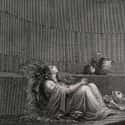-

(#10) Infants Were Abandoned And Immured
In some cases, immurement was the cause of death for infants. Bricking up or enclosing a wall or entrance wasn't even necessary since little babies are unable to attempt escape. But why would anyone immure a newborn? Some answers include: poverty, fear, and shame.
Very poor families could not afford another mouth to feed, so infants were left wherever they would not be found. In ancient Rome, for example, it was not terribly frowned upon to kill babies as a form of birth control, since they were not considered to be completely human. Other infants might be killed because their mothers - sex workers or victims of rape - were ashamed of them.
Whatever the reason, babies were abandoned in catacombs, cloisters, cisterns, and cells. They were left to die, their only crime: existence.
-
(#6) King Richard II Of England Was Bricked Up
King Richard II of England ruled during the age in which Geoffrey Chaucer wrote his famous Canterbury Tales. It was a time of chivalry and Richard's court was considered one of beauty and fashion. He was so interested in beauty, art, and culture that he lost track of political situations in his country.
Richard was deposed by a powerful rival. Having lost his crown, he was sent off to a castle where he presumably starved to death. Apparently, his murderers felt immurement was the best method to rid themselves of the former king since starvation would not show any marks or damage to the body.
-
(#4) Clerics Who Molested Boys Were Starved To Death In A Suspended Coffin
In 1409, four Christian clerics in Augsburg, Bavaria, were found guilty of pederasty, or sexual conduct with young boys. Pederasty was not only considered immoral but also illegal.
The church in Augsburg locked the guilty men into wooden coffins, suspended them with ropes from high inside a tower, and left them to starve. They were then buried under the gallows.
-
(#2) The Perfect Punishment For Lustful Vestal Virgins
Ancient Roman religion was taken seriously by its leaders, practitioners, and even the secular government. As with most societies, there was also an ongoing concern over the chastity of women and how a woman's natural lust was overwhelming and thus, had to be controlled. Vestal Virgins, or female temple priestesses of the goddess Vesta, were held to a particularly high standard of conduct. All took a solemn vow of chastity.
However, the priestesses were human and sometimes faltered. This was not a problem unless their lustful activities were discovered. On such occasions, a guilty priestess received capital punishment. This most often took the form of permanent immurement.
The Vestal Virgin would be stripped, beaten, dressed in the clothing of a corpse, and then placed in a catacomb or cave. Typically, she would be locked or bricked away with a small supply of food, water, and candles or lamps. When the supplies ran out, the Vestal Virgin would die a slow agonizing death.
-
(#1) Immurement Did Not Necessarily Mean Death - Unless They Forgot About Leaving You There
Many cases involving immurement were doled out to intentionally serve as very slow death penalties. However, immurement could also be a temporary condition which was used in one of two ways: as a form of punishment or by choice for a given length of time. The medieval Christian church used temporary immurement as a method to punish sinners, particularly those who committed sins of the flesh. Such individuals were locked away deep in a monastery or bricked up inside of rooms with a tiny opening for food and water for months or even years.
Centuries later, this type of immurement was still being used, but as a form of punishment. A good example comes from the unfortunate end of James Hepburn, third husband of Mary, Queen of Scots, who was accused of treason. After fleeing Scotland, he was apprehended in Denmark where he was imprisoned beneath Dragsholm Castle. He was put in a hole that was not large enough for him to stand in and subsisted off of food scraps in total darkness.
Danish authorities more or less forgot about Hepburn, and he remained in his hole for five years. When he was finally found, he acted like a feral animal. Hepburn did not use language, but instead only grunted and paced back and forth. He died shortly after.
Some cases of immurement had willing participants. Christian monks and nuns participated in immurement as a spiritual experience. They would choose the method, location, and length of time involved.
-
(#11) Young Maidens Were Lowered Into Cisterns As A Human Sacrifice
The Festival of the Sun is the most important religious celebration in Ancient Inca culture. It was a major event during ancient times that lasted for nine days and was filled with colorful dances and processions as well as animal sacrifices to thank the gods for a good harvest. Music was played and the people shared food.
Following the arrival of the Catholic Spaniards in the 16th century, the festival was banned for many years. While the Spaniards were determined to convert the Inca people to Catholicism by whatever means necessary, perhaps one of their reasons for banning the festival was the tradition of human sacrifice by immurement. After performing certain ceremonial duties, a number of young maidens, around 12 years of age, were lowered into a waterless cistern and sealed within it.
New Random Displays Display All By Ranking
About This Tool
Burial alive is a commonly used punishment in wars and is generally used for mass killings. There is no doubt that being buried alive or bricked up is one of the most painful and terrifying disasters so far. The suffering is that it allows the victim to clearly feel the process of the death, asphyxiation and hypoxia are more painful than other punishments. Those who have deep thoughts about history will never deny that these cruel
punishments have occurred frequently in human history.
History is full of terrible stories of people being bricked up or buried alive, and even some religious ceremonies or ancient customs regard these ways as sacred. The random tool shares 11 stories of people who bricked up or buried alive in history.
Our data comes from Ranker, If you want to participate in the ranking of items displayed on this page, please click here.















